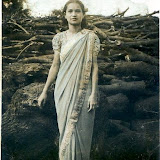At the third glass his eyes got brighter, and he began to talk … of strange scenes and doughty deeds, of wars and plagues and strange peoples …
… “I’d like to go to India myself,” said the old man, “just to look round a bit, you know.”
“Better where you are,” said the sergeant major, shaking his head. He put down the empty glass, and sighing softly, shook it again.
W. W Jacobs; The Monkey’s Paw
Something happened to India in the 1860s. It had always been strange to the western imagination but now it became a land of occult mystery; at least it did in popular fiction. Once it had been a blighted land, mostly used as a device to conveniently kill off secondary characters, now army officers were returning with talismans or strange powers they’d picked up (stolen, more usually) from some distant temple. Think of Wilkie Collins’ The Moonstone, W. W Jacobs’ The Monkey’s Paw and quite a few of the Sherlock Holmes stories. In 1879 Helena Blavatsky met Alfred Percy Sinnett, editor of the Pioneer newspaper in India, and moved the headquarters of the Theosophical Society to Bombay. Four years later Sir Richard Burton published the first translation of the Kama Sutra. The three of them gave an intellectual credibility to the idea of the mysterious east that made the most ludicrous story of ancient curses feasible. Photography also had a part to play in this transformation; the camera brought the country to life in ways that confirmed the wildest tales, and Darwin was also important. For a lot of people the theory of natural selection didn’t destroy religion so much as make it, the western version, trite and uninteresting. Rather than embracing atheism they looked for alternative religious ideas, of which India had a multitude. Cholera and restless natives were still dangerous but now India was also the home of snake charmers and other magicians and just possibly secrets of inner wisdom long lost in the west.
These photographs come from a small, yellow album and were most likely taken in the 1930s. They appear to be a mix of the owner’s personal snapshots and others bought in souvenir albums, though which is which is sometimes hard to tell. Throughout the album the owner has written descriptions in painstaking calligraphy and on a couple of pages added deft sketches of local types wearing fezzes and turbans. The skill in this work suggests he or she might have been a draughtsman for an engineering or architectural company, or even a journalist since at that time the ability to knock off a quick sketch was still valued by newspapers. One page has two photographs of British people – two of them officers - relaxing at Ootacamund, a hill station and resort in Tamil Nadu. A woman is in one of the photographs and there is no reason to think this wasn’t her work in the album.
Whoever put the album together, it was obviously intended to be more other than a collection of holiday snaps. It has something in common with the Gaumont or Burton travel films of the era; ‘impressions of India’, if you like, with sequences of scenes showing the architecture, the people, the land and so on. Most of us can probably recognize this India from old novels and films like Kim and The Man who would be King. It was the India that was so thoroughly distilled in the European consciousness it is impossible to be rid of even now when India means Bollywood and economic statistics.
It is said that every stereotype has a grain of truth to it, or as David Cronenberg put it more bluntly; ‘every stereotype is true’. This album could be seen as a collection of stereotypes but if you think that you also have to ask whether the photographer went out in search of or happened upon them by chance, and if it is the second does that make them more authentic? Obviously, like any snapshot album, this one involved some judicious editing beforehand but photographs have a way of making a case in ways the written word can never match. ‘This is the India of our imagination’, the album’s creator is saying; ‘and I have the proof it is real’.
VIEW THE GALLERY HERE
 |
| PASSAGE TO INDIA |




Lovely architecture makes me feel like visiting them..
ReplyDelete